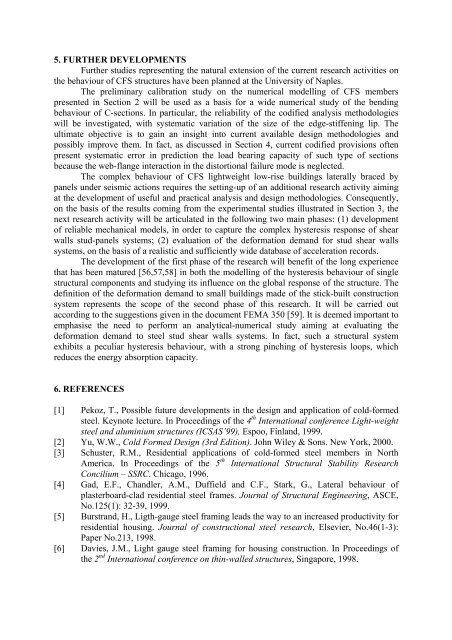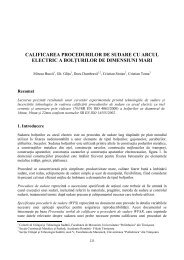cold-formed steel structures: advances in research and design - apcmr
cold-formed steel structures: advances in research and design - apcmr
cold-formed steel structures: advances in research and design - apcmr
- No tags were found...
You also want an ePaper? Increase the reach of your titles
YUMPU automatically turns print PDFs into web optimized ePapers that Google loves.
5. FURTHER DEVELOPMENTSFurther studies represent<strong>in</strong>g the natural extension of the current <strong>research</strong> activities onthe behaviour of CFS <strong>structures</strong> have been planned at the University of Naples.The prelim<strong>in</strong>ary calibration study on the numerical modell<strong>in</strong>g of CFS memberspresented <strong>in</strong> Section 2 will be used as a basis for a wide numerical study of the bend<strong>in</strong>gbehaviour of C-sections. In particular, the reliability of the codified analysis methodologieswill be <strong>in</strong>vestigated, with systematic variation of the size of the edge-stiffen<strong>in</strong>g lip. Theultimate objective is to ga<strong>in</strong> an <strong>in</strong>sight <strong>in</strong>to current available <strong>design</strong> methodologies <strong>and</strong>possibly improve them. In fact, as discussed <strong>in</strong> Section 4, current codified provisions oftenpresent systematic error <strong>in</strong> prediction the load bear<strong>in</strong>g capacity of such type of sectionsbecause the web-flange <strong>in</strong>teraction <strong>in</strong> the distortional failure mode is neglected.The complex behaviour of CFS lightweight low-rise build<strong>in</strong>gs laterally braced bypanels under seismic actions requires the sett<strong>in</strong>g-up of an additional <strong>research</strong> activity aim<strong>in</strong>gat the development of useful <strong>and</strong> practical analysis <strong>and</strong> <strong>design</strong> methodologies. Consequently,on the basis of the results com<strong>in</strong>g from the experimental studies illustrated <strong>in</strong> Section 3, thenext <strong>research</strong> activity will be articulated <strong>in</strong> the follow<strong>in</strong>g two ma<strong>in</strong> phases: (1) developmentof reliable mechanical models, <strong>in</strong> order to capture the complex hysteresis response of shearwalls stud-panels systems; (2) evaluation of the deformation dem<strong>and</strong> for stud shear wallssystems, on the basis of a realistic <strong>and</strong> sufficiently wide database of acceleration records.The development of the first phase of the <strong>research</strong> will benefit of the long experiencethat has been matured [56,57,58] <strong>in</strong> both the modell<strong>in</strong>g of the hysteresis behaviour of s<strong>in</strong>glestructural components <strong>and</strong> study<strong>in</strong>g its <strong>in</strong>fluence on the global response of the structure. Thedef<strong>in</strong>ition of the deformation dem<strong>and</strong> to small build<strong>in</strong>gs made of the stick-built constructionsystem represents the scope of the second phase of this <strong>research</strong>. It will be carried outaccord<strong>in</strong>g to the suggestions given <strong>in</strong> the document FEMA 350 [59]. It is deemed important toemphasise the need to perform an analytical-numerical study aim<strong>in</strong>g at evaluat<strong>in</strong>g thedeformation dem<strong>and</strong> to <strong>steel</strong> stud shear walls systems. In fact, such a structural systemexhibits a peculiar hysteresis behaviour, with a strong p<strong>in</strong>ch<strong>in</strong>g of hysteresis loops, whichreduces the energy absorption capacity.6. REFERENCES[1] Pekoz, T., Possible future developments <strong>in</strong> the <strong>design</strong> <strong>and</strong> application of <strong>cold</strong>-<strong>formed</strong><strong>steel</strong>. Keynote lecture. In Proceed<strong>in</strong>gs of the 4 th International conference Light-weight<strong>steel</strong> <strong>and</strong> alum<strong>in</strong>ium <strong>structures</strong> (ICSAS’99), Espoo, F<strong>in</strong>l<strong>and</strong>, 1999.[2] Yu, W.W., Cold Formed Design (3rd Edition). John Wiley & Sons. New York, 2000.[3] Schuster, R.M., Residential applications of <strong>cold</strong>-<strong>formed</strong> <strong>steel</strong> members <strong>in</strong> NorthAmerica. In Proceed<strong>in</strong>gs of the 5 th International Structural Stability ResearchConcilium – SSRC. Chicago, 1996.[4] Gad, E.F., Ch<strong>and</strong>ler, A.M., Duffield <strong>and</strong> C.F., Stark, G., Lateral behaviour ofplasterboard-clad residential <strong>steel</strong> frames. Journal of Structural Eng<strong>in</strong>eer<strong>in</strong>g, ASCE,No.125(1): 32-39, 1999.[5] Burstr<strong>and</strong>, H., Ligth-gauge <strong>steel</strong> fram<strong>in</strong>g leads the way to an <strong>in</strong>creased productivity forresidential hous<strong>in</strong>g. Journal of constructional <strong>steel</strong> <strong>research</strong>, Elsevier, No.46(1-3):Paper No.213, 1998.[6] Davies, J.M., Light gauge <strong>steel</strong> fram<strong>in</strong>g for hous<strong>in</strong>g construction. In Proceed<strong>in</strong>gs ofthe 2 nd International conference on th<strong>in</strong>-walled <strong>structures</strong>, S<strong>in</strong>gapore, 1998.
















